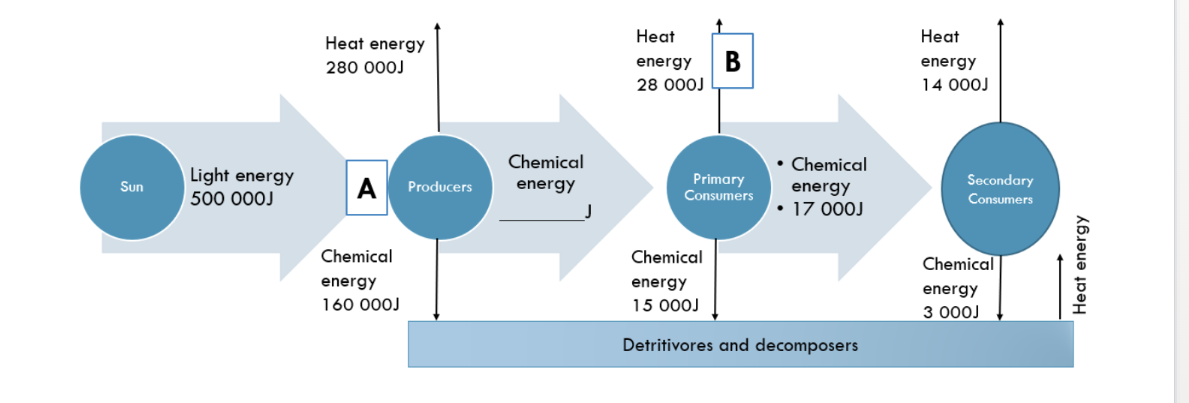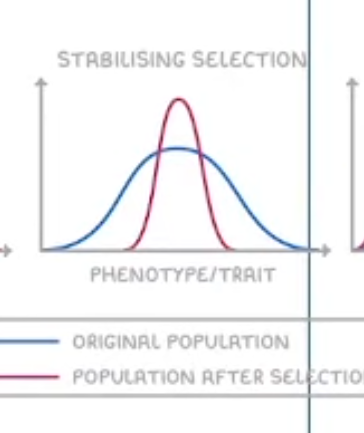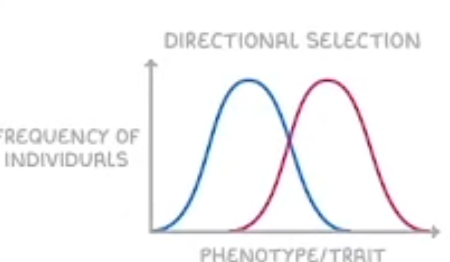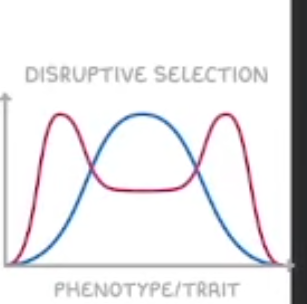Biology Unit 3
1/81
There's no tags or description
Looks like no tags are added yet.
Name | Mastery | Learn | Test | Matching | Spaced |
|---|
No study sessions yet.
82 Terms
Explain the Prey - Predator cycle
t As prey populations increase, predator populations also rise due to abundant food, leading to a subsequent decline in prey numbers, which eventually causes predator populations to decrease as food becomes scarce.
When looking at transects and calculating percentage folio cover
look at the highest PLANT layer, don’t count anything that is too high or anything that is too small. there might be an emergent
When looking for uncertainties look for
Standard Deviation or if one data set has more samples than the other, or inconsistencies within the sample
Energy Flow Diagram
Just look at how much energy is transferred for a certain species (e.g consumer). the amount of energy transferred should be equal to the amount for respiration (heat energy), chemical energy to the decomposers and then the amount of energy that will be transferred to next species

When it asks to make a justified conclusion, e.g the first data set make a conclusion about the water quality, try and use
data given such as the p -value
Species Richness
the number of different species represented in a given ecological community or sample.
Relative species Abundance (species eveneness)
proportion, population of each species relative to the other ones. helps figure out if a species is dominant or if all the species are even (population)
What are the 4 species interactions/ biotic factors/ limiting factors/ classification by species interactions
Predation - predators may evolve strategy (e.g. nocturnal hunting)
Symbiosis - close, long - term biological interaction between species
Competition - Species compete for the same resources
Disease - pathogenic condition caused by a pathogen or parasite, can be affected by seasonal factors and population density
What are the 4 different types of symbiotic relationship
Mutualism - both species benefit from the relationship
Commensalism - one species is benefited, the other unaffected
Amensalism - one species is harmed, the other unaffected
Parasitism - one species benefits, the other is harmed
Abiotic conditions
Climate - temperature, pH, salinity, availability of water, precipitation, wind
Substrate (type of surface - soil, sand)
Size/depth
natural disasters
the different definitions of species
biological - a group that can interbreed and produce fertile offspring
morphological - based on physical differences in form and structure
Phylogenetic - defines species by shared ancestry and unique evolutionary history
ecological - defined by the resources they use
Linnean taxonomy
Domain
Kingdom
Phylum
Class
Order
Family
Genus
Species
what are R-strategists
Species that priortise high reproductive rates, with minimal parental care. Typically grow quickly, have short life spans and low carrying capacity
what are K-strategists
Species that focus on long-term survival, producing fewer but larger offspring with significant parental care. Grow slowly, have longer life spans, higher carrying capacity
What are three assumptions/ components of cladograms
Common Ancestor
Bifurcation - splitting into two unique species
Physical change - observable differences that occur between species
What are quadrats mainly used for
Useful for unform areas and provides data on density, frequency, and percentage cover
What are line transects mainly used for
A line used to sample across environmental gradients and investigate changes over time
Strengths and limitations of random sampling
Suitable for statistical inference
Reduces bias → every location has an equal chance of being sampled, giving fairer representation.
Simple to use → easy to set up with random number generators
Limitations:
May miss rare species
Uneven coverage
Strengths and limitations of systematic sampling
systematic sampling means taking samples at regular intervals along a line or grid.
Example: placing quadrats every 2 m along a transect from the high tide line down to the low tide line.
✅ Strengths
Good coverage along gradients → ensures samples are evenly spread and environmental changes are captured.
Simple and repeatable → easy to set up and replicate, reducing human error.
❌ Limitations
Not truly random → introduces potential bias, since some points in the habitat never get sampled.
May miss patchiness → if species are clumped in between sampling points, they might be overlooked.
formula for Net primary production
NPP = GPP (Gross Primary Production) - energy lost (respiration)
Water cycle
Evaporation → water changes from liquid to vapour (oceans, lakes, rivers).
Transpiration → water vapour released from plants.
Condensation → vapour cools and forms clouds.
Precipitation → rain, snow, sleet, or hail falls to Earth.
Infiltration → water soaks into soil and becomes groundwater.
Runoff → water flows over land back into rivers, lakes, and oceans.
Nitrogen Cycle
Nitrogen fixation → N₂ gas → ammonia (NH₃) or ammonium (NH₄⁺) by bacteria/lightning.
Nitrification → ammonia → nitrites (NO₂⁻) → nitrates (NO₃⁻) by nitrifying bacteria.
Assimilation → plants absorb nitrates → build proteins/DNA.
Ammonification → decomposers break down organic matter → release ammonia.
Denitrification → denitrifying bacteria convert nitrates back into N₂ gas.
Nitrogen fixation – N₂ → NH₃/NH₄⁺
Nitrification – NH₄⁺ → NO₂⁻ → NO₃⁻
Assimilation – plants absorb NO₃⁻/NH₄⁺ → animals eat plants
Ammonification – organic waste/dead matter → NH₄⁺
Denitrification – NO₃⁻ → N₂ (back to atmosphere)
Keystone Species
A keystone species is one that has a disproportionately large impact on the structure and function of an ecosystem, relative to its abundance — if it’s removed, the whole ecosystem can change dramatically.
Succession
process by which communities of plants and animals colonise an area and overtime replaced by more varied organisms
Primary Succession
plants grow where no plants have grown before and there is no SOIL
Secondary Succession
plants grow where there has been a previous population that were destroyed by something like fire
Why are pioneer species effective and some examples
ability to fixate nitrogen
tolerance to extreme conditions
rapid germination of seeds
photosynthesis
examples: lichens, moss, algae
DNA, what is it, where is it in eukaryotes and prokaryotes
deoxyribonucleic acid
In eukaryotes, DNA is found in the nucleus, bound to histone proteins (forms chromosomes)
In prokaryotes, DNA exists as unbound circular DNA in the cytosol
Nucleotides
Building blocks of DNA
Has a nitrogenous base, phosphate group, deoxyribose sugar
Nitrogenous base (adenine, guanine, cytosine, thymine )
Adenine with Thymine, Adenine with Guanine
DNA replication - how it works, steps involved
Initiation - helicase unwinds the DNA by breaking hydrogen bonds between base pairs. The two strands separate into leading and lagging strands.
Binding of Primase - synthesises a short RNA primer on the leading strand and multiple primers on the lagging strand
Elongation - DNA polymerase binds to the RNA primer and begins adding complementary nucleotides
In what direction does DNA polymerase
Builds the new strand in the 5’ to 3’ direction,
Leading strand
The leading strand template (the original strand being copied) runs 3′ → 5′ towards the replication fork. (direction where helicase is and its opening up the fork)
This orientation lets DNA polymerase build the new complementary strand smoothly in the 5′ → 3′ direction
Lagging strand
The lagging strand runs in the 5’ - 3’ direction towards the fork
Homologous chromosome
A homologous chromosome pair = two separate chromosomes, one from a person’s mother, one from the same person’s father.
Spermatogenesis
End Products - four spermatoza (haploid)
Duration of Process - continuous from puberty throughout life
Number of Gametes Produced - 4
spermatogonia (2n) undergoes mitosis to form primary spermatocytes (2n)
primary spermatocytes undergoes meiosis I to form secondary spermatocytes (n)
secondary spermatocytes undergo meiosis II to form spermatids haploid
Oogenesis
End Products - one ovum (haploid), two or three polar bodies
Duration of Process - starts before birth, pauses at prophase 1 until puberty, resumes with each mensural cycle, completes fertilization
Number of Gametes Produced - 1 (ovum)
Oogonia (2n) —> primary oocytes (2n) - mitosis
primary oocytes —> secondary oocytes (n) -meiosis 1
secondary oocytes —> mature ovum (2) - meiosis 2
Gene
Regions of DNA that are made up of nucleotides
‘coding’ regions of DNA (exons) and ‘non coding’ regions of DNA
Genome
all the genetic material in the chromosomes of an organism, including its genes and DNA sequence
What is transcription
(DNA → mRNA)
Occurs in the nucleus.
RNA polymerase unzips DNA and builds a complementary mRNA strand from the template strand.
mRNA is processed (splicing, cap, tail) and then leaves the nucleus
What is translation
(mRNA → protein)
Occurs at the ribosome (in cytoplasm).
tRNA molecules bring amino acids, matching their anticodons to codons on the mRNA.
Ribosome links amino acids into a polypeptide chain (protein).
For example:
A gene for muscle repair → transcription + translation produce muscle proteins (like actin or myosin).
A gene for enzymes → produces that specific enzyme.
Purpse of Gene expression
to produce functional gene products, which can be proteins or functional RNA
Factors regulating gene expression
Transcription/translation - proteins can control the rate and time
Gene Products - the products of other genes can influence the expression of certain genes
Environmental Exposure - external factors such as environmental changes, can influence gene expression
transcription factosrs
a transcription factor is a protein that controls the rate of transcription of genetic information from DNA to mRNA, by binding to a specific DNA sequence. The function of TFs is to regulate—turn on and off—genes in order to make sure that they are expressed in the desired cells
Differential gene expression
regulated by transcription factors, crucial for cell differentiation and the development of tissues and morphological features in organisms
HOX Genes
transcription factor gene that controls the body plan and morphology
SRY gene (sex-determining region Y)
Regulates the differentiation of male-specific tissues during development
Mutations: DNA replication error
Point mutation - a change in a single nucleotide, which may result in altered protein function
Frameshift mutation - an insertion or deletion of nucleotides which can shift the whole protein, causing major disruption in protein synthesis - way bigger mutation
Mutations: Cell division
Non-disjunction - chromosomes fail to separate properly, leading to an abnormal number of chromosomes
Mutations: Mutagens
Environmental factors
Physical mutagen - UV radiation
Chemical mutagen - certain chemicals
Heat - extreme temperatures can induce change
Aneuploidy
non-disjunction can lead to this
its where the chromosome numbers deviate from the normal diploid set (2 chromosome)
example having 3 chromosomes in the 21st pair leads to down syndrome - Trisomy 21
Monosomy - 1 chromosome only (absence of a chromosome)
Trisomy - 3 chromosomes (extra chromosome)
Polygenetic Inheritance
when multiple genes contribute to a single trait, leading to a wide range of phenotypes
e.g. skin colour, height
Genotype and Phenotype difference
Genotype → the genetic makeup of an organism; the specific alleles it carries.
Example: Aa, AA, or aa for a single gene.
Phenotype → the observable traits or characteristics that result from the genotype and environment.
Example: brown eyes, tall height, or skin colour.
What is the purpose of PCR (Polymerase Chain Reaction) and its steps
Polymerase Chain Reaction (PCR) is used to make millions of copies of a specific DNA segment from a small sample.
Denaturation (95 °C)
Heat separates the two DNA strands (breaks hydrogen bonds).
Annealing (50–65 °C)
Short primers bind (anneal) to the target DNA sequence.
Extension (72 °C)
Taq polymerase (Heat Stable DNA Polymerase) adds nucleotides to the primers, building new complementary strands.
These steps are repeated for many cycles (25 - 30)
What is the purpose of Gel Electrophoresis
Used to separate DNA (or RNA/proteins) fragments based on size and charge, creating a characteristic banding pattern which —>
Helps with DNA profiling, checking PCR results, and analysing genetic variation.
Prepare gel (agarose for DNA). Wells are made at one end.
Load DNA samples mixed with a dye into the wells.
Apply electric current: DNA is negatively charged, so fragments move towards the positive electrode.
Separation occurs:
Smaller fragments move faster/further,
Larger fragments move slower/shorter distance.
Visualise bands under UV light or with a stain.
DNA Recombination
To combine DNA from two different sources → create new genetic combinations. Used in GMOs, insulin production, vaccines, gene therapy, etc.
Steps of Recombinant DNA
Cut DNA
Use restriction enzymes to cut DNA at specific sequences (producing sticky ends).
Insert gene
Target gene is inserted into a vector (e.g. plasmid, virus).
Join DNA
DNA ligase seals the gene into the vector (forms recombinant DNA).
Transform host
Recombinant vector is inserted into a host cell (like bacteria).
Expression
Host cell replicates and expresses the new gene → produces protein of interest (e.g. insulin)
Evolution
The change in the genetic composition of a population over successive generations, driven by natural selection, mutation, gene flow, and genetic drift
could form new species
Microevolution
Small-scale evolutionary changes (allele frequencies) within a population or species over short time frames.
within species
Macroevolution
Large-scale evolutionary changes that occur over long geological time, leading to the formation of new species or higher taxonomic groups.
beyond species
Evolutionary Radiation
refers to rapid diversification of species from a common ancestor, often following a mass extinction or environmental change
Natural Selection
Occurs when environmetal pressures favour a specific phenotype, giving it a selective advantage for survival and reproduction
these preferred traits have a higher chance of surviving and reproducing, causing these traits to become more common in population over generations
Positive allele frequency selection
increasing the frequency of beneficial alleles
Negative allele frequency selection
Decreasing the frequency of harmful alleles
Stabilising selection
Favours the average phenotype against extremes
Effect on population: reduces variation and maintains traits around a central value

Directional Selection
Favours one extreme phenotype/trait (either left or right)
Shifts population traits toward one extreme

Disruptive selection
Favours both extreme phenotypes, selecting against intermediate
Can lead to two distinct phenotypes and potentially speciation

Microevolutionary Change: Mutation
A random change in the DNA sequence of an organism
Introduces new alleles into a population’s gene pool, providing genetic diversity. can be beneficial, neutral or harmful
Microevolutionary Change: Gene Flow
The movement of alleles between population due to migration.
can introduce new alleles to a population making them more diverse
can also reduce genetic differences between populations making them more similar over time
Microevolutionary Change: Genetic Drift
Random change in allele frequencies in a population, typically small
can lead to loss of alleles and reduce genetic diversity
Bottleneck Effect
Occurs when a large population is drastically reduced by a random event (e.g. natural disaster, disease, human activity).
Only a small number of individuals survive, carrying a reduced gene pool/genetic diversity
Founders Effect
Occurs when a small group separates from a larger population and establishes a new colony.
The new population has allele frequencies that may not represent the original population.
results in loss of genetic diversity and different allele frequencies
What are the four different macroevolutions/species diversification
Divergent Evolution - Species with a common ancestor evolve to become different over time due to different environments
Convergent Evolution - Unrelated species evolve similar traits due to facing similar environmental pressures or challenges, despite not having a common ancesor
Parallel Evolution - species with a common ancestor evolve in a similar way even after becoming geographically separated, often due to similar environmental conditions
Coevolution - When two species evolve in response to each other’s changes over time.
Modes of Speciation
Allopatric speciation - Occurs when a population becomes geographically isolated from the rest. Isolated population may undergo genetic divergence due to mutation, gene flow, natural selection, resulting in a new species
Sympatric speciation - Occurs within the same geographical area, population diverges with no physical barrier. Can result from behavioral changes, ecological niches, mutations that reduce gene flow
Parapatric Speciation - A form of speciation where populations are partially separated geographically (adjacent but not completely isolated).
There is limited gene flow between the populations, but different selection pressures in their local environments cause them to diverge genetically.
Over time, this leads to the formation of new species despite the populations still being in contact along a “border zone.”
why mRNA codes for different proteins in cells even though all cells have the same DNA apart from sex cells
Selective gene expression → leads to different mRNAs being made → which leads to different proteins being produced → which is why a muscle cell behaves differently from a neuron or a skin cell.
what are population-independent (density-independent factors)
are environmental conditions that affect populations regardless of its density/size. These factors are typically abiotic and include weather events, natural disasters, pollution, and habitat destruction.
what is an interspecific hybrid
An interspecific hybrid is an offspring produced by the mating of individuals from two different species, e.g. a mule, which is the offspring of a horse and a donkey.
What is a sampling technique vs method
A sampling technique is the type or strategy (random, systematic, stratified sampling)
A sampling method is the practical procedure or equipment (quadrats, line transects, belt transects)
What is crossing over in meiosis
Crossing over involves homologous chromosomes exchanging portions of their DNA.
QCAA question: describe
For a mutation to pass down generations
The mutation must occur in a sex cell, so they can be passed down into the offspring (gametes).
Somatic mutations → stay in one individual (not inherited).
Germline (sex-cell) mutations → can be inherited by offspring and cause changes in any organ or trait.
The sex cell’s DNA is copied into every cell of the child’s body, including heart cells, brain cells, etc.
Meiosis/independant assortment
During meiosis I, each homologous chromosome pair (one maternal + one paternal) can line up in two possible orientations — either the maternal or the paternal chromosome goes into a gamete.
Since humans have 23 pairs, the number of possible chromosome combinations is 2²³ (~8 million).
Independant assortment
Independent assortment is the random and independent orientation of homologous chromosome pairs along the equator of the cell during metaphase I of meiosis